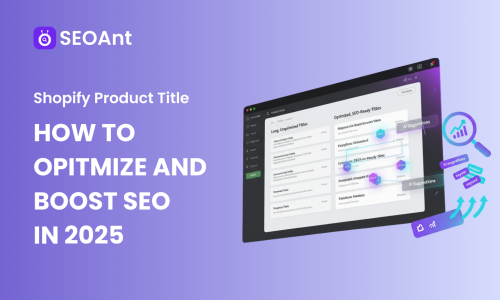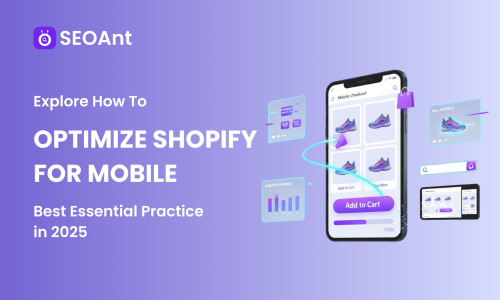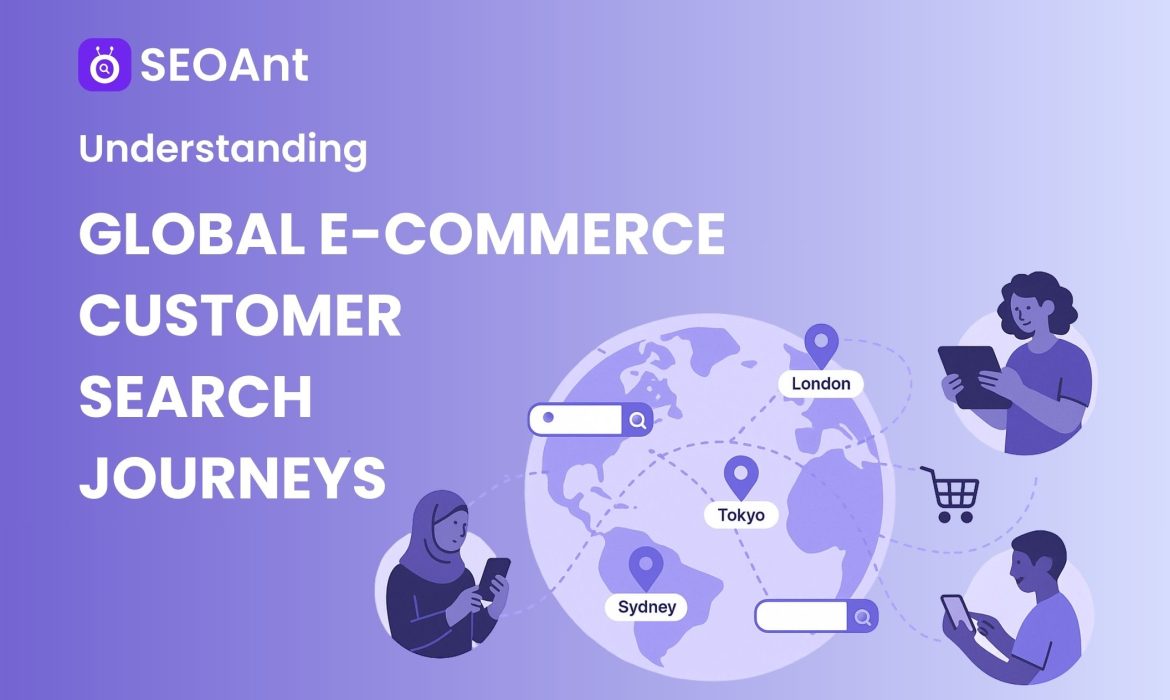
In our interconnected digital marketplace today, 68% of online experiences begin with search engines all over the world, yet most e-commerce companies struggle with the understanding of how customers actually search for and buy their products. Whether you’re developing your first online store, or extending a brick-and-mortar store into international e-commerce, understanding the E-commerce customer journeys is the key to on-going growth and success.
This guide will take you through the elements of customer search behavior, discuss how cultural norms can affect e-commerce customer online buying behavior across global markets, and provide useful tools for maximizing your e-commerce strategy in general. By understanding these global E-commerce customer journeys you will be able to develop targeted marketing plans, increase conversion rates and build lasting customer relationships across the globe.
Table of Contents
What is the E-commerce Customer Journey in Today’s Global Market?
The e-commerce customer journey includes the entire path a potential customer takes from recognizing a need, through the purchase and beyond. Unlike a conventional linear sales funnel, today’s customer search behavior is a complex journey with many touchpoints that differ greatly in markets and cultures around the world.
The stages of the digital buyer journey are connected, but they are often not linear; customers move back and forth between the research, comparison, and decision-making phases. To guide and support the e-commerce buyer journey, it’s important to understand that complexity when developing an international marketing strategy that is relevant to global audiences.
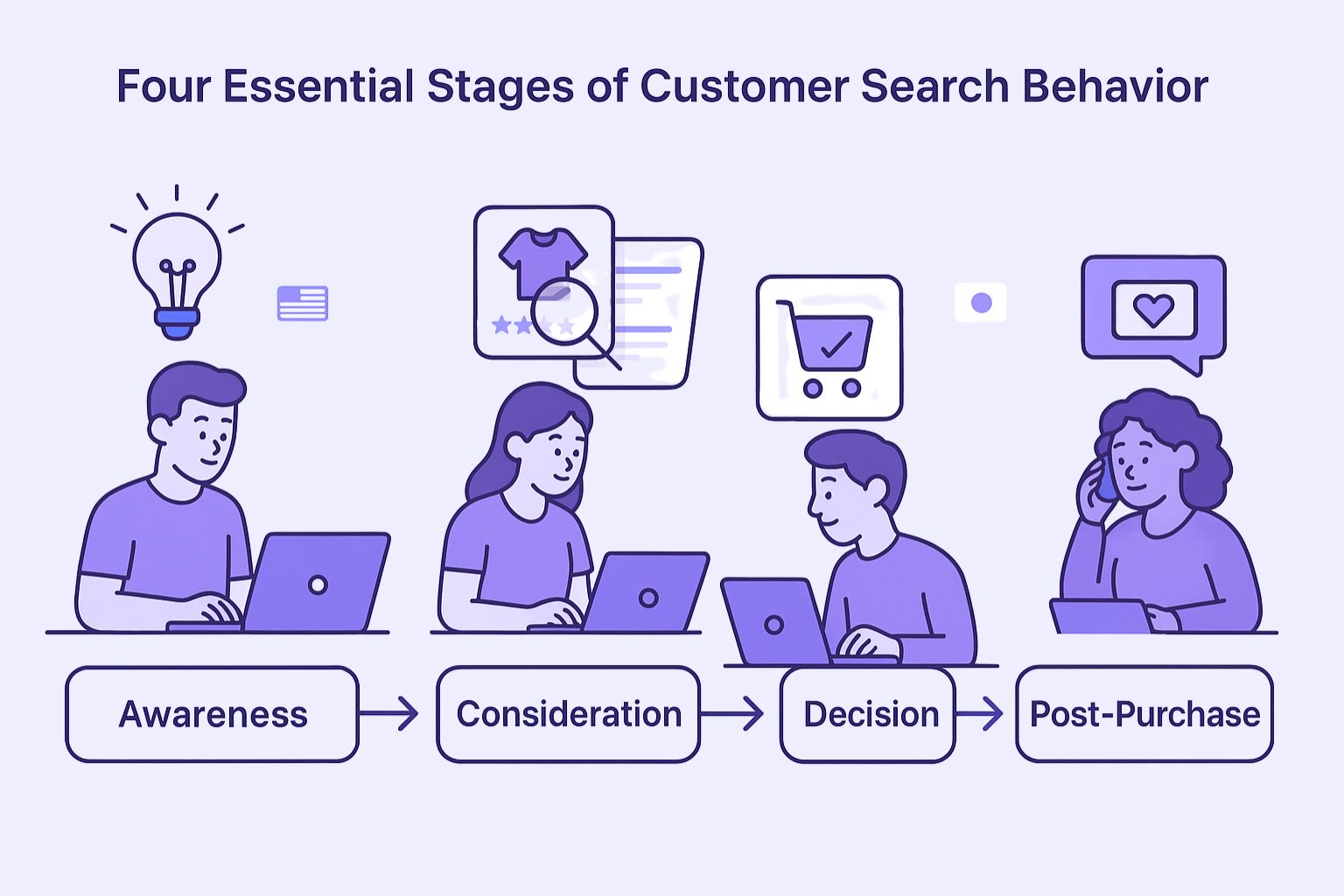
The Four Essential Stages of Customer Search Behavior
| Stage | Description | Typical Search Queries | Regional / Cultural Nuances | Key Business Focus |
| 1. Awareness Stage Need Recognition & First Search | Customers realize a need/problem and begin broad, educational searches. | “Best ways to improve posture at work”“Ergonomic solutions for office workers” | – North America: Immediate, solution-focused – Europe: General content, news, sustainability research | Create educational, customer-centric content tailored to regional expectations. |
| 2. Consideration Stage Solution Assessment & Comparison | Customers compare solutions, brands, and features, becoming more product-oriented. | “Best ergonomic chairs 2024”“Compare ideas for standing desk brands” | – Asia-Pacific: Heavy reliance on social proof & peer recommendations – North America: Prioritize efficiency & price comparisons – Sustainability & certifications valued | Provide detailed comparisons, reviews, certifications, and product-focused content. |
| 3. Decision Stage Purchase Decision & Buying Process | Customers show intent to buy with transactional queries; focus on pricing & checkout. | “Buy Herman Miller chair save 10%”“Steelcase office chair free shipping” | – Germany: Prefer invoicing & detailed specs – Australia: Local delivery options & strong after-sales support | Optimize product pages, ensure transparent pricing, and provide localized payment/shipping options. |
| 4. Post-Purchase Stage Customer Support & Re-Purchase | Focus shifts to engagement, product use, and repeat purchase opportunities. | “How to set up Herman Miller chair”“Care instructions for standing desk”“Best accessories for ergonomic chairs” | Varies by culture: Preferred communication modes & loyalty expectations | Offer strong support, loyalty programs, personalized recommendations, and localized engagement. |
Cross-Cultural E-commerce Customer Journey Differences
Cultural factors impact how consumers interact with online shopping processes. Language differences influence variation in search terms, for example, British consumers may search for “colour” and American consumers may search for “color”. While these differences may seem small and technical, the variation accumulates across the entire customer journey and impacts everything from their first blog post to their last purchase.
Requirements to build trust will vary significantly between cultures. Scandinavian customers may expect long, convoluted privacy policies and detailed company operations, whilst Latin Americans might deem personal recommendations far more valuable and accept testimonials as valid sources of information. Understanding these expectations will enable companies to tailor their strategy to have the most impact in the relevant market.
Patterns of influence from social media also differ. Customers in some Asian markets expect that social media platforms and e-commerce will be more integrated, figuring out what to buy without leaving social platforms, whereas Western markets have a clearer distinction between social and transactional experience and will prefer that an e-commerce option is a better-designed version of the platform they typically use.
Essential Customer Touchpoints in Global E-commerce
In order to map customer touchpoints in e-commerce, we must think about the diverse and complicated channels and interactions that influence how consumers shop online. Consumers today are engaging with a brand’s touchpoints on multiple platforms and/or devices before deciding whether or not to purchase, making customer touchpoint attribution difficult for businesses and therefore difficult to justify marketing spend.
Digital Touchpoints Across the Customer Journey

Search Engine Interactions
Search engine use is still the main WAY to find global e-commerce shoppers. On a search engine, organic search results can offer credibility and authority to your brand while paid ads can offer immediate location for a highly competitive keyword. Shopping results help facilitate all of this for the consumer by allowing them to see product information directly in the search experience. Search query transactions continue to reduce friction in the decision-making process when it comes to discovery and purchase consideration.
Social Media Engagement Points
Social media platforms serve different roles across global markets. Instagram and Pinterest drive visual product discovery, particularly for fashion, home decor, and lifestyle products. Facebook provides community-based recommendations and detailed product discussions, while LinkedIn influences B2B purchase decisions through thought leadership content.
TikTok has emerged as a powerful discovery platform for younger demographics, with short-form video content driving impulse purchases and brand awareness. Understanding platform preferences by demographic and region helps optimize social media touchpoint strategies for maximum impact.
Website and App Interactions
The navigation behavior on the website’s homepage suggests patterns of customer intent and can help you refine experiences tailored to specific market segments. Engagement with product pages, regardless of format, provides indications of content effectiveness and can help identify optimization opportunities. View and ratings consultation patterns reveal different cultural dispositions around social proof and recommendations from peers.
A mobile app interaction provides even more robust behavior data and can support personalized experiences that drive loyalty to your brand. When culturally appropriate, push notifications can help guide customers through the purchasing process and encourage repeat interactions.
Measuring Touchpoint Effectiveness Across Global Markets
Attribution modeling can be challenging, especially when analyzing customer online activity on a global scale. Old-fashioned last-click attribution does not adequately take into consideration how the new reality of customers’ multi-touchpoint pathway considers all of their travel, particularly when customers conduct research one country and purchase in another country.
Today’s advanced analytics platforms are capable of sophisticated attribution modeling to take into account cross-device behavior, elongated consideration periods, and the influence of offline touchpoints on online purchasing. You can have new insights based on these advanced analytics with more accurate measurement of ROI and reinterpretation of budget allocation between global marketing channels.
Lastly, customer journey analytics tools provide visualization of standardized paths to purchase, while also identifying opportunity to advance optimization and possible friction. Once you understand the path to purchase, you can decide what touchpoints do the most to influence your business versus your competition within the specific global market segment.
Understanding the Psychology of International Online Shoppers
The global customer search behavior psychology provides interesting discoveries that shape the influences of cultural values, economic conditions, and social norms on customer decisions when shopping online. From the customer’s initial search query to their final purchase decision and post-purchase satisfaction level, these psychological constructs affect customer behavior.
Decision-Making Factors Across Different Markets
Trust and security considerations differ widely across global markets, depending on local banking systems, regulatory environments, and cultural views toward online transactions. For example, Scandinavian countries tend to have a high amount of trust in digital payment systems, while markets with less developed e-commerce infrastructure are likely to require more security statements and alternative payment options.
Price sensitivity patterns reflect economic conditions and cultural norms that affect spending and saving. For example, German consumers frequently value durability and value more than lowest price. Price-sensitive markets like India concentrate on discounts and promotional offerings. These understandings improve pricing strategies and the messaging in promotions across varying geographies.
Brand loyalty variations across cultures also influence customer retention strategies and calculations of customer lifetime value. Japanese consumers exhibit higher brand loyalty after purchase than consumers in the United States, who are often inclined to switch brands for a better deal or upgraded features. These behaviors will affect customer acquisition costs and development of retention strategies, as examples.
Emotional Triggers and Cognitive Biases in Global E-commerce
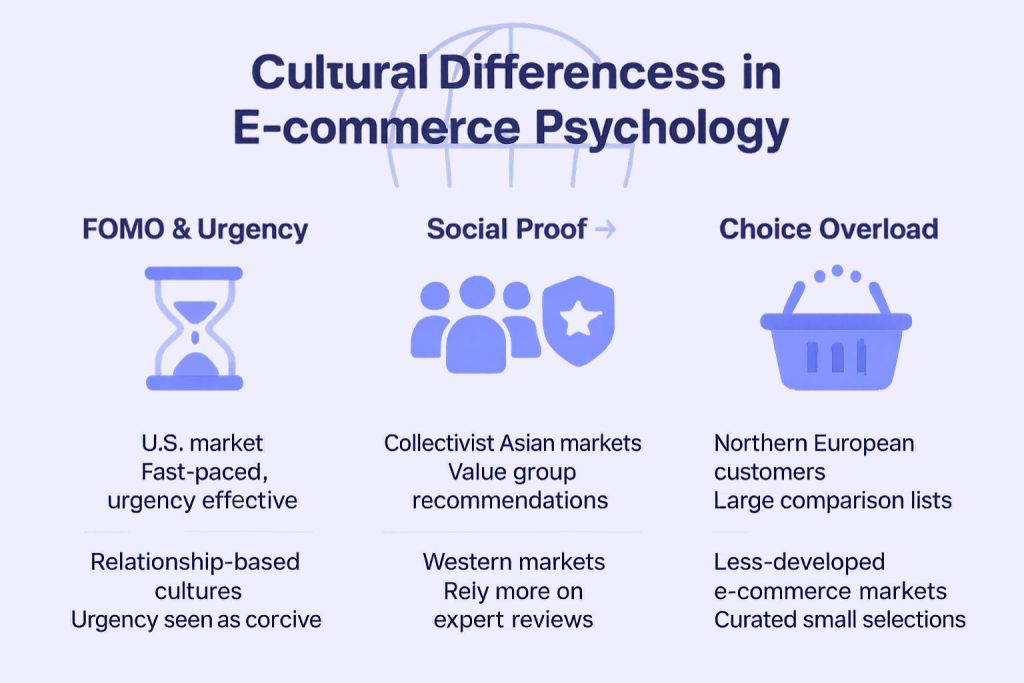
Using fear of missing out (FOMO) in your marketing requires cultural sensitivity. While urgency messages are effective in fast-paced markets like the U.S., a fast-paced messaging strategy may appear to be coercive in a culture focused on constructing relationships. Different cultures respond to emotional appeals in different ways; understanding what is or isn’t an appropriate emotional appeal can prevent cultural missteps and damage to your brand.
Markets that rely on social proof to drive behaviors are vastly different between individualistic cultures and collectivistic cultures. When driving social proof in Asian markets, the impact of group recommendations and popularity indicators seems more pronounced when compared to Western markets, which tend to rely more on recommendations from experts and specifications around product attributes before purchasing. Adapting social proof strategies to fit both the cultural preferences and expectations impacts your conversion rates and customer satisfaction.
Customers across markets interact with choice overload differently when considering the final purchase. Some global markets embrace long lists of options without issue; others prefer selections, or buckets, of curated offerings. An example of this is that Northern European customers seem to prefer exhaustive comparisons of product offerings before making a purchase while less developed e-commerce markets are likely to appetite simplified choice architectures designed to combat decision fatigue when shopping online, due to lack of experience shopping via a global e-commerce architecture.
Beginner-Friendly Tools for E-commerce Customer Journey Analysis
Getting started with customer journey analytics doesn’t require expensive enterprise software or extensive technical expertise. Several powerful, beginner-friendly tools provide valuable insights into customer behavior patterns and help optimize the online shopping experience for global audiences.
Free Analytics Platforms for Journey Tracking
| Tool | Capabilities | Key Benefits for Global E-Commerce |
| Google Analytics 4(GA4) | – Enhanced measurement features – Customizable conversion tracking – Goal funnels & conversion paths – Mobile app integration for cross-device behavior | – Sophisticated customer journey tracking – Visualizes drop-off points for optimization – Identifies international audience segments & behaviors |
| Google Search Console(GSC) | – Reveals search queries driving traffic – International targeting reports – Click-through rate (CTR) analysis – Position tracking over time | – Understands customer intent via search terms – Identifies regional performance & expansion opportunities – Measures SEO improvements across markets |
| Heatmap & User Behavior Tools (e.g., Hotjar) | – Visual heatmaps of user interactions – Click tracking – Scroll depth analysis- Form interaction tracking | – Shows what elements users engage with or ignore – Optimizes content length & structure for different markets – Identifies checkout or lead-gen friction points |
Advanced Analysis Techniques for Growing Businesses
Customer journey mapping workshops convene teams to visualize and assess the entire customer experience from different angles. Workshops help teams see where gaps exist between how they envision the customer will experience the product or service versus how customers actually experience it, which is a significant consideration when expanding into different global markets with different cultural expectations. Using insights from SEOAnt, businesses can map customer behavior and also get an understanding of search visibility touchpoints to verify that their content is in line with how international customers actually search.
To develop global market personas, it is essential to conduct research into cultural values, communication preferences, and shopping behaviors specific to the target region. Well-developed personas guide content creation, user experience design, and marketing message development to appeal to a variety of international audiences. By layering in data from SEOAnt related to keywords and search trends, businesses can create personas that are aligned with how customers behave and how different geographic locations communicate their needs via a search engine.
A/B testing for journey optimization also allows for data-driven improvements throughout the customer experience. Testing the different approaches in different segments of the market reveals cultural preferences and opportunities for optimization that probably won’t be found when analyzing general analytics. In this case, SEOAnt supports tracking the outcome of on-page SEO changes, different data metadata, and content optimization tests to provide teams with actionable evidence of what is generating better engagement and search rankings opportunities.
Implementing Customer Journey Insights for Global E-commerce Success
In order to translate an analysis of the customer journey into actual business improvement, organizations need to have a systematic approach to implementing the information they learn across their content strategy, technical foundation, and continuous optimization processes. Successful global e-commerce businesses will learn to use customer journey insights to inform their strategic planning and tactical improvements in order to systematically improve the customer experience and build a sustainable growth engine.
Content Strategy Optimization for Global Audiences
Creating Content That Matches Global Customer Journey Stages
Content in the awareness stage should address prevalent questions and problems potential customers are searching for in various global markets. This consists of blog articles with educational content, how-to guides, and industry insight, that provides expertise and builds trust with international audiences. By being culturally sensitive with content production, we can be sure our messaging resonates appropriately with the given market segment.
Content in the consideration stage emphasizes products and services through detailed comparisons, explanations of features, and situation studies that empower customers to evaluate options. Content must acknowledge regional preferences and highlight features that are more prevalent in the market. You also want to include customer testimonials from applicable geography to help build credibility and trust.
Content in the decision stage of the funnel helps eliminate the customer’s final purchase barriers, by providing clear product information, transparent pricing, and easy shopping cart process. There are times when trust signals such as certification security symbols, return policies, and seller services are essential for converting international customers with concerns about making a cross-border transaction.
Technical Implementation for Global E-Commerce Customer Journeys
Optimizing site speed becomes paramount for international audiences since load speeds can differ significantly between areas and regardless of the internet infrastructure that forms the basis for its access. Content Delivery Networks (CDNs) can be used to ensure loading times are generally fast regardless of location. In addition, image optimization and refined coding practices can help limit what must be downloaded in the way of bandwidth, so that users with slower connection speeds can get the content more quickly.
Mobile-first designs take into account that many of the international markets are more mobile than desktop or PC. Responsive design can help ensure that users will have a good experience regardless of device. Mobile-friendly features, such as one-click checkouts or digital wallet integration, can address payment methods or customs in different regions of the world.
International SEO involves issues related to implementation of the hreflang, optimizations for local keywords, or understanding the relationship between geography and preference for specific search engines. Although Google is leading in most markets, specialized optimization practices apply for areas like Russia (Yandex) or China (Baidu).
Continuous Improvement and Adaptation Strategies
Regular journey analysis and updates ensure customer experience optimization keeps pace with changing market conditions and customer expectations. Monthly analytics reviews help identify trends and seasonal patterns that affect customer behavior in different global markets.
Customer feedback integration provides qualitative insights that complement quantitative analytics data. Surveys, reviews, and direct customer communication reveal cultural preferences and pain points that might not be apparent through behavioral data alone.
Performance monitoring across markets helps identify successful strategies that can be scaled to new regions and underperforming areas that require attention. Cross-market comparison reveals opportunities for improvement and best practices that can be adapted for different cultural contexts.
Mastering Global E-commerce Customer Journeys
Understanding global E-commerce customer journeys provides the foundation for building successful international online businesses. The complexity of modern customer behavior, influenced by cultural differences, technological adoption, and regional preferences, requires sophisticated yet practical approaches to customer experience optimization.
The four essential journey stages – awareness, consideration, decision, and post-purchase – remain consistent across global markets, but the specific behaviors, preferences, and expectations within each stage vary significantly between regions. Successful businesses acknowledge these differences and adapt their strategies accordingly, rather than applying one-size-fits-all approaches that may alienate potential customers.
Cultural sensitivity in customer journey optimization extends beyond language translation to encompass payment preferences, communication styles, trust-building requirements, and decision-making processes. Businesses that invest time in understanding these cultural nuances create competitive advantages and build stronger relationships with international customers.
Immediate Action Steps for E-commerce Beginners
Start by implementing basic analytics tracking on your website to understand current customer behavior patterns. Google Analytics 4 and Google Search Console provide free, powerful insights into customer journeys and search behavior that can guide initial optimization efforts.
Conduct customer interviews or surveys to understand motivations, concerns, and preferences specific to your target markets. This qualitative research complements quantitative analytics data and reveals cultural insights that inform content and user experience decisions.
Create customer journey maps for your primary market segments, identifying touchpoints, pain points, and optimization opportunities. Use these maps to prioritize improvements that will have the greatest impact on customer experience and business results.
Focus on mobile optimization as a priority, given the high mobile adoption rates in many global markets. Ensure your website provides excellent user experience across all devices and loading conditions.
Building Long-term Global E-commerce Success
Customer journey optimization is an ongoing process that requires continuous learning, testing, and adaptation. As markets evolve and customer expectations change, successful businesses maintain flexibility and responsiveness to emerging trends and preferences.
Invest in understanding emerging technologies like voice search, artificial intelligence, and augmented reality that are beginning to influence customer journeys. Early adoption of these technologies, where culturally appropriate, can provide competitive advantages in global markets.
Build relationships with local partners and experts in target markets who can provide cultural insights and market intelligence. These partnerships help navigate complex cultural nuances and avoid costly mistakes when expanding into new regions.
Remember that mastering global E-commerce customer journeys is a journey itself – one that rewards patience, cultural sensitivity, and commitment to continuous improvement with sustainable international growth and success.
Frequently Asked Questions About E-commerce Customer Journeys
What is the e-commerce customer journey?
The E-commerce customer journeys is the complete process a customer goes through from recognizing a need to making a purchase and beyond. It includes all touchpoints and interactions between the customer and your brand across multiple channels and devices, typically spanning awareness, consideration, decision, and post-purchase stages.
How do customers behave when shopping online?
Online customer behavior varies significantly across global markets, but generally includes extensive research, price and feature comparisons, review reading, and multi-device browsing before making purchase decisions. Modern customers often interact with brands across multiple touchpoints before converting, making the journey complex and non-linear.
What are the stages of online customer journey?
The online customer journey typically includes four main stages: 1) Awareness (recognizing a need), 2) Consideration (researching and comparing solutions), 3) Decision (choosing and purchasing), and 4) Post-purchase (support, reviews, and repeat purchases). Each stage requires different content and optimization strategies.
Why is customer journey mapping important for e-commerce?
E-commerce customer journeys mapping helps businesses understand customer needs, identify pain points, optimize touchpoints, and create more effective marketing strategies. For global e-commerce, it’s essential for understanding cultural differences and adapting strategies for different international markets to improve conversion rates and customer satisfaction.









